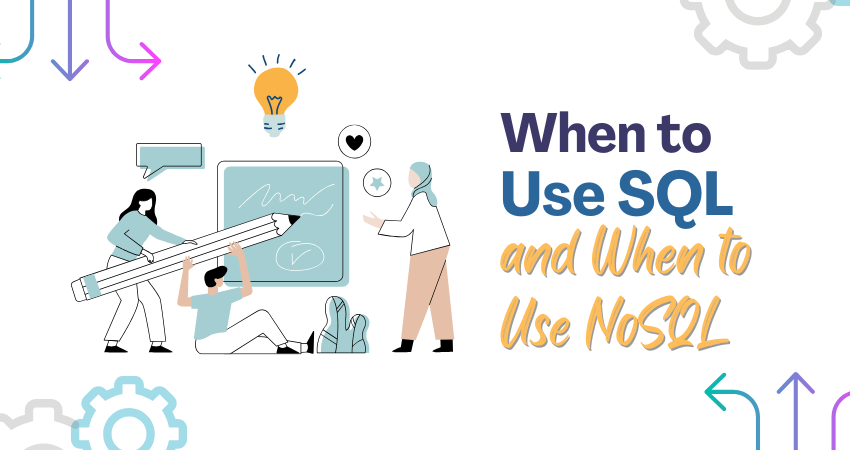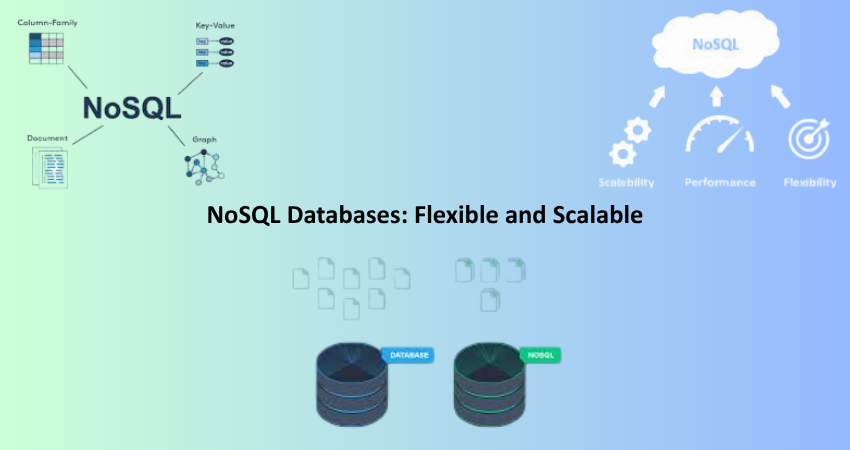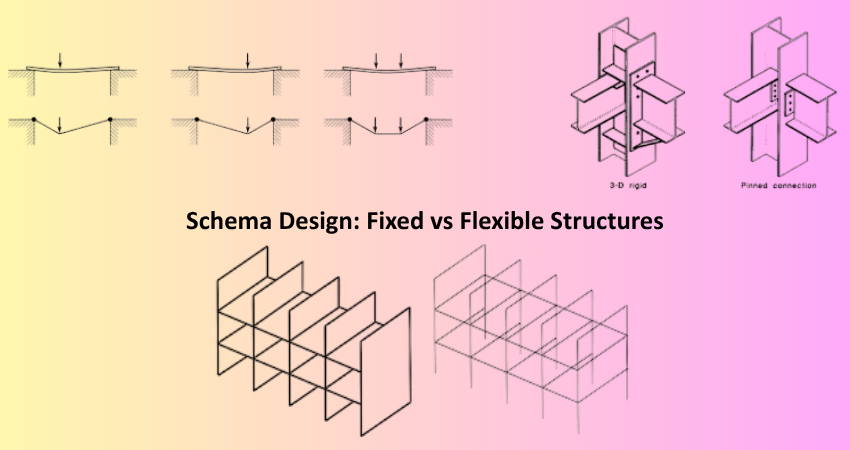
Introduction
Database systems have been the bedrock upon which application performance, scalability, and manageability rests in this data-driven world. SQL (Structured Query Language) and NoSQL (Not Only SQL) are the two predominant types of databases that provide different models for storing and retrieving data. SQL databases are well established and have been supporting enterprise-wide data operations for decades, while NoSQL databases are known for flexible data modeling, scalability, and support for unstructured data and have gained great popularity recently. Fostered with the right ambiance, an understanding of choosing NoSQL or SQL would greatly empower developers, data architects, as well as business stakeholders to take informed decisions regarding software and systems development.
In this complete guide, we will look at the basic differences between SQL databases and NoSQL databases and present a detailed examination of the use cases where each performs the best. From structure and scalability to flexibility and data integrity, each has its benefits and scenarios. Examining technical architecture and applications as well as providing examples from the real world allow this article to shed some light on the specific needs of a project for a choice of database type. From a small blog to a financial platform to an enormous big data application, each database has a rewiring effect on performance and maintainability.
SQL Databases: Structured and Reliable
Understanding SQL Architecture and Data Modeling
An SQL database, or as commonly called, a relational database, organizes data in the form of tables, rows, and columns. This model relies on relational algebra that makes it possible to accurately constrain schemas along with its ACID (Atomicity, Consistency, Isolation, Durability) properties for integrity. SQL databases, for instance, MySQL, PostgreSQL, or Microsoft SQL Server, can be configured only after a schema is created, which means that they require a well-structured definition of the data to be inserted. In other words, the format of the data must be known and consistent, and relationships between data entities must be strictly enforced.
The greatest strength of SQL databases remains in maintaining connections between entities via foreign keys and join operations. Such potentials are suitable for applications involving complex querying and relational data like financial systems, ERP systems, and CRM platforms. Convertible complex queries written in SQL can produce an immensely accurate data manipulation and retrieval facility. Validation of data rules ensures accuracy and consistency, which are often crucial in environments where correctness of data is not up for debate. SQLs stringent lines could confuse as a limitation, yet it can provide standardization and predictable usage, which would be very important for bigger, regulated businesses.
Best Use Cases for SQL: Transactional and Relational Workloads
SQL databases come into existence with applications that have a need for transactional integrity, consistency, and complex interrelationships amongst data entities. For instance, a financial system processing millions of monetary transactions every day must ensure no data loss or inconsistent writes. SQL databases are highly suitable for such transactions as they provide ACID compliance. E-commerce sites require strong data integrity and the ability to perform complex joins to maintain their inventory levels, payment processing, and customer order management, which SQL manages with relief.
SQL databases further excel in any application that uses structured data and requires a lot of complex reporting beyond these two scenarios. Applications like Tableau, Power BI, and a host of other business intelligence platforms integrate very effectively with such databases to create very insightful dashboards. Such industries that heavily rely on relational databases include healthcare, banking, and government, with their mature ecosystems, matured security practices, and compliance capabilities. SQL database reliability ensures that critical information is always correct, accessible, and very much save. SQL is your go-to language if your application involves structure, security, and multi-row transaction processing.
NoSQL Databases: Flexible and Scalable

Exploring NoSQL Models and Design Flexibility
Going against the relational model, NoSQL databases come with their varied data storage techniques: document-based (MongoDB), key-value stores (Redis), wide-column stores, and graph databases (Neo4j). NoSQL schemes, by contrast, are flexible so that developers can store different types of data in the same collection or even in the same document, unlike SQL, which has a fixed schema. Therefore, NoSQL is great for applications in which the data structure may evolve over time or vary widely from record to record.
The greatest phenomenon about NoSQL is that it does justify the acceptance of unstructured data, semi-structural data, or polymorphic data. New-generation applications, especially those in the field of IoT, social media, or big data, really need to ingest data in numerous varied formats like JSON, XML, or CSV. Such events are NoSQL’s forte; they are designed for these conditions. NoSQL databases support denormalization, where related data is stored together in one document for rapid access and to minimize joins. The horizontal-scalability feature of NoSQL systems is another reason it is best suited to high-throughput distributed environments where the challenges of scaling any SQL solution would be exorbitantly costly.
Ideal Scenarios for NoSQL: Scalability and Speed
When consistency and structure are not investigation cases anymore, NoSQL is the right tool for scalability and fast access of data. Facebook, Twitter, and Netflix are just a few companies that run NoSQL databases to facilitate billions of operations across their user bases daily. Herein lies the need for a database that can easily scale across multiple nodes while maintaining high availability to manage user-generated content such as comments, likes, or multimedia uploads.
NoSQL has been beneficial for real-time analytics engines and recommendations engines. The ability to absorb streaming data-whether clickstreams or sensor outputs-wide-column NoSQL databases such as Cassandra store a lot of time-series data for analytical purposes. Besides that, built-in NoSQL sharding or partitioning made it easy to carry out horizontal scaling without much effort on behalf of the developer. Applications that want to go global with minimal latency, such as the backends for multiplayer gaming or e-commerce stores under heavy international traffic, can use the NoSQL setup to spread the replicated data across regions. NoSQL was picked when speed, scale, and flexibility mattered to the designers.
Performance Considerations: Speed vs Integrity
How SQL Performs Under Transactional Loads
SQL databases operate under ACID-compliance, ensuring that either every transaction happens or none of it” prevents data from being corrupted. SQL’s ability to apply atomicity to control concurrent access by queuing and processing transactions preserves data integrity with system failure incidents, for instance, banks or e-commerce checkout systems where highly concurrent transactional loads are present. Tuning the performance of SQL systems is through indexing, query optimization, normalization, and connection pooling.
In any case, SQL databases may occasionally be the victim of performance bottlenecks when simultaneously flooded with millions of concurrent transactions. Whenever complex joins appear or many tables are being manipulated with one transaction, this will necessitate expensive horizontal scaling, which requires adding more and more server cluster nodes to keep the SQL running as desired. However, while a handful of modern SQL engines do implement read replication and partitioning, they fall far short of the transparency with which these features are implemented in most NoSQL engines. Thus, SQL shines in terms of reliability and precision, but that glory withers in the face of tuning and architectural foresight to preserve performance at a large scale.
NoSQL’s Strength in High-Throughput Environments
NoSQL databases excel and intentionally designed for environments that have high throughput and low latency. Most NoSQL systems, for performance and scalability reasons, sacrifice full ACID compliance to allow them to perform many simultaneous reads and writes with little overhead. For example, the key-value store Redis can serve millions of requests per second, making it ideal for cases such as caching, session storage, and leaderboard rankings in gaming applications.
And indeed, NoSQL distributes the datasets across multiple nodes using methods such as auto-sharding and replication, providing it with inherent horizontal scalability. Applications can now grow elastically with demand without being worried about a single point of failure. In write-heavy environments such as IoT telemetry, e-commerce activity logs, or social media feeds, NoSQL would improve write performance and availability as opposed to other databases. This mode of operation would tend to compromise on immediate consistency, but most could offer eventual consistency as guarantees that work in most real-world applications. Speed and scale are fundamental considerations where NoSQL wins.
Data Integrity and Consistency Models
SQL’s Guarantee of Strong Consistency
The SQL databases have a strong consistency model. Based on the ACID principles, they ensure reliable processing of all operations on the database while preserving integrity. Such a transaction is isolated and consistent from one another such that it preserves the valid state of the database, even under adverse conditions like being faced with errors or failures. This feature is so very important for applications such as banking, healthcare, or supply chain management, in which even the smallest inconsistency could lead to worse atrocity or financial loss.
SQL databases enforce referential integrity, thus ensuring the correct relationship between the tables. The records linked to the parent table attributes will be automatically updated or deleted on cascading rules when a given parent table record is deleted. Given such a level of data integrity, SQL is the best candidate for working with normalized data models where relations are paramount. While sometimes viewed as a limitation, such rigidity becomes a vital strength in maintaining compliance and coordinating sound reporting practices in highly regulated environments.
Eventual Consistency in NoSQL: Pros and Cons
This contrasts with some NoSQL databases, which rely on the concept of eventual consistency; that is, once a write operation occurs, the data may not be visible to all nodes for some time, but sooner or later, it all becomes consistent. This trade-off gives a system greater availability and performance while ensuring it operates in a distributed environment. Use cases where it is acceptable for some time to elapse before real-time propagation of data is typically found have eventual consistency, like social feeds, product recommendations, or telemetry data collection.
In terms of applications requiring accurate real-time synchronized access in distributed environments, eventual consistency usually does not yield a good experience. In e-commerce applications, for instance, having inconsistent cart states, along with delay in cart’s real-time inventory updates, could lead to a very poor user’s application experience. However, some NoSQL databases come with tunable settings for consistency, which allow the developers to choose from the trade-offs in consistency, availability, and partition tolerance (CAP Theorem). However, that flexibility comes with the burden of more complexity for development and maintenance. The developers have to determine which portions of the system can afford to delay consistency and build accordingly.
Schema Design: Fixed vs Flexible Structures

The Rigid Yet Predictable Schema of SQL
The SQL schema definition is quite an asset while being a setback. The entire hyphenated structure ensures that data follows a certain format, which is very much a consideration for applications demanding specific data formats, such as financial reporting, auditing, and compliance check codes. The predictability of SQL schemas allows teams to easily create reliable ETL pipelines, perform database-layer validations, and write optimized queries using pre-defined indexes.
Furthermore, the maintenance of the structure encourages healthy maintenance and collaboration. Therefore, in the long-term schema can stand the test of time. Developers, analysts, and data engineers can quickly familiarize themselves with the data model, write optimized queries, and establish compliance with data governance policies. The flip side of the coin is that this same rigidity means that any change to the data model-now adding a new column or altering data types-needs to be carefully planned and carried out. Schema migrations in SQL databases take a long time and can wreak havoc, especially for systems with large datasets or whose availability requirements are paramount.
NoSQL’s Dynamic Schema and Its Impact on Agility
Incorporating NoSQL databases allows for the flexibility of having multiple records in a single internal structure, enabling teams to be quick and agile in meeting client requirements without high-cost migrations. This is especially helpful when the agile development environment needs newer features faster and the changes made to the data model are frequent. So, for example, in document-based databases such as MongoDB, developers could add fields on the fly and the document would adjust itself accordingly, making the application more well-adjusted to business needs.
On the other hand, that flexibility gives rise to the possibility of incurring data inconsistency and increasing the cost of maintenance if the requirements come from outside. Without enforced schema rules, different documents within the same collection may have an inconsistent structure, leading to problem areas concerning querying, indexing, and validating the data. Although some NoSQL systems have schema-validation capabilities within the application layer or through the plug-in, this will require much discipline and documentation all over the development team. However, to start-ups or MVPs or applications that handle diverse data formats, the ability of NoSQL to operate with dynamic schemas is most often a big plus.
Conclusion
Gone are the exhaustive debates over new-age technology-SQL or NoSQL; the answer to the query is simply application-nature-specific. SQL databases, however, are bound for highly complicated systems driven by relationships and compliance, where transaction integrity, structure, and reliability dearly matter. Its cold performance shines in cases where consistency in data and a relational model are essential. By contrast, NoSQL offers flexibility and the ability to scale with very high performance for applications requiring rapid distributed access to unstructured or semi-structured data. NoSQL fits architecture for the modern web, mobile, and real-time analytics applications where models are changed frequently or focus is on performance at scale.
In the end, hybrid approaches are slowly invading the market. This age has seen blends of the architectural principles of SQL and NoSQL to obtain maximum benefits. An example may include using a relational DB for core business transactions and NoSQL for real-time analyses or caching layers. Knowing the differences between SQL and NoSQL assists you in making a wise choice, avoids expensive errors, and builds applications that are more sturdy and scalable. Choosing this or that database, be it a new architecture design or an optimization for an existing setup, will bring success if the choice is correlated with functional, technical, and business requirements.